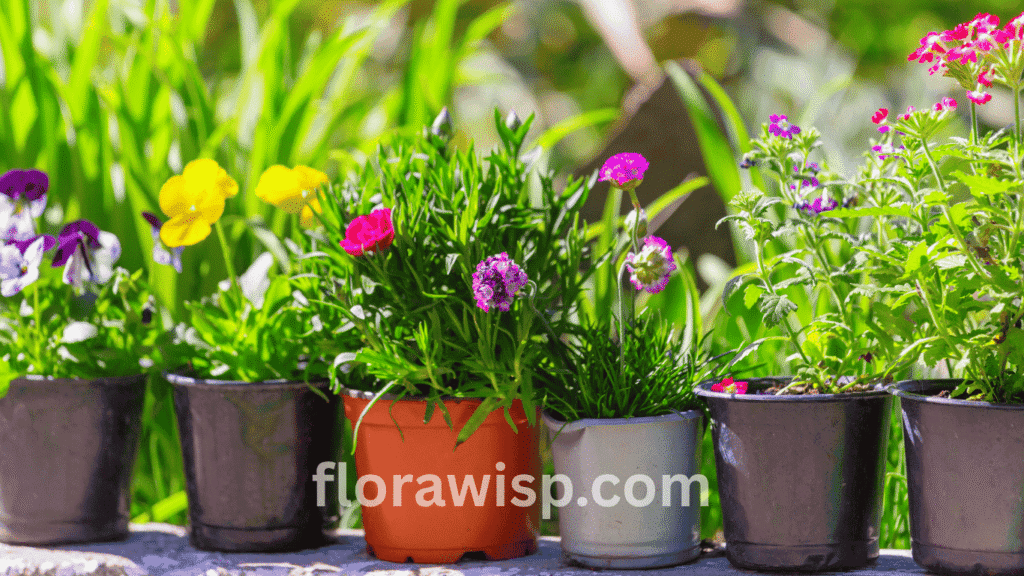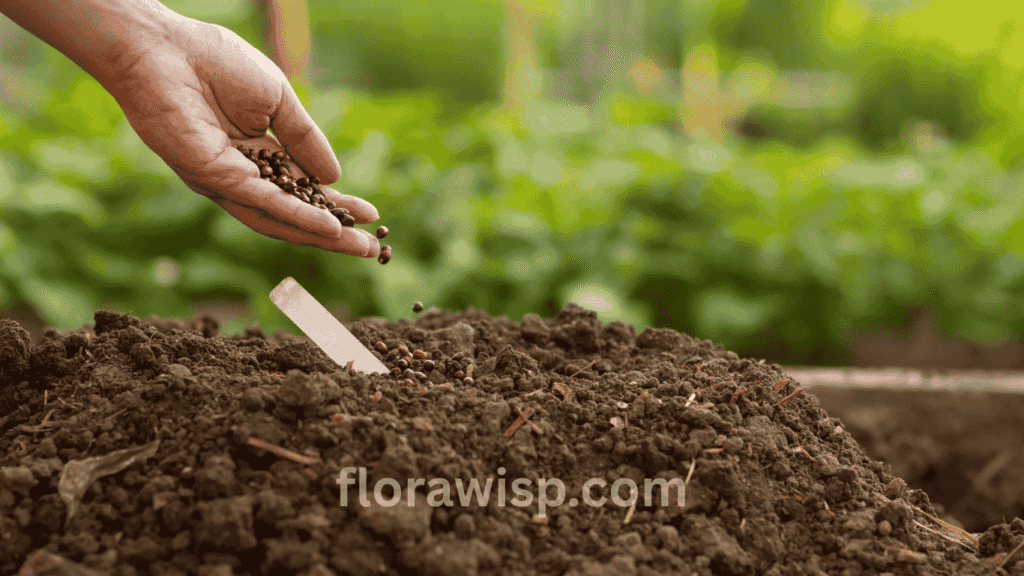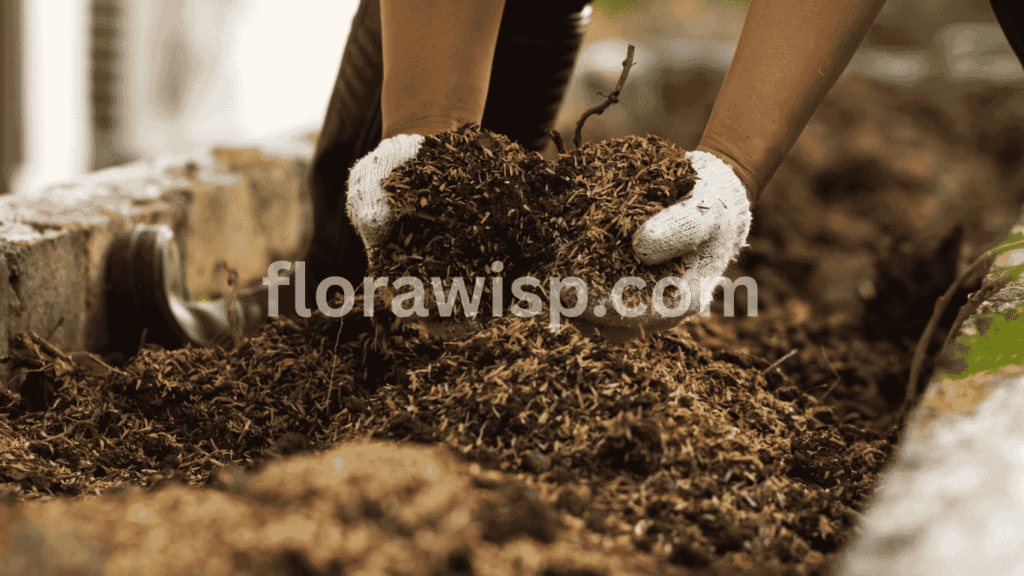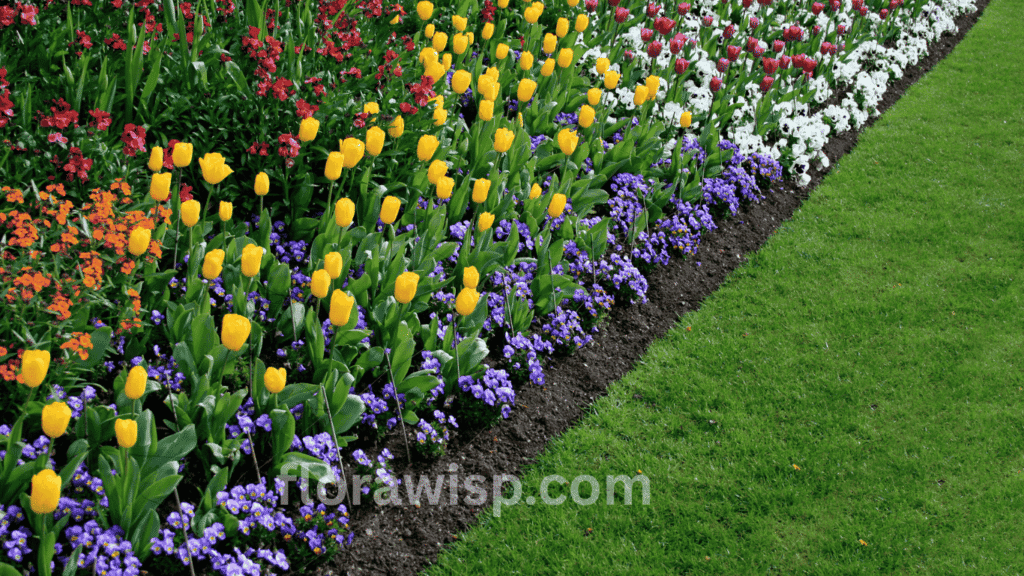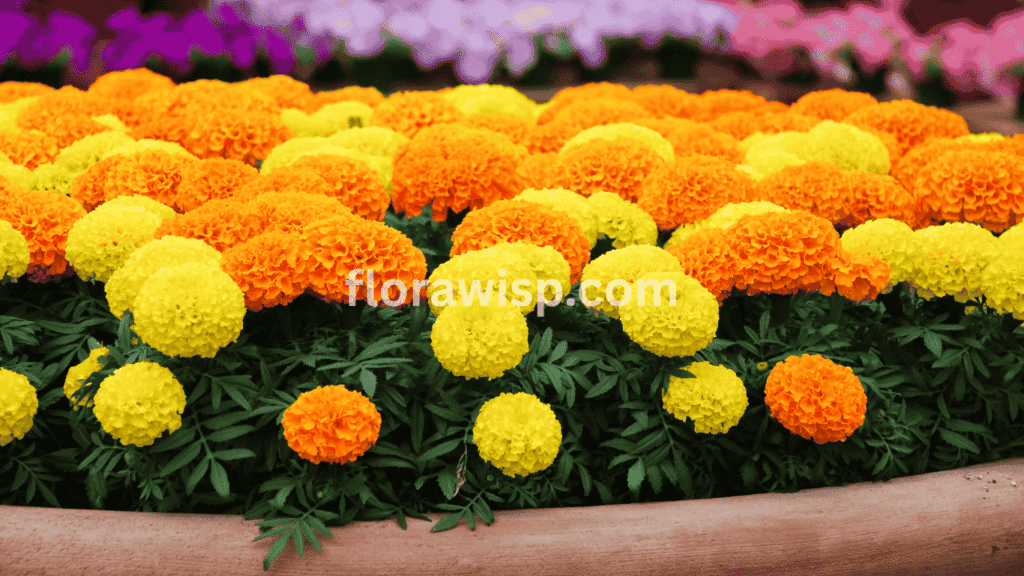Discover 9 stunning ways to style flowers in pots plus expert tips most gardeners miss. Give your patio or balcony a vibrant upgrade today! If you’ve ever glanced at a patio overflowing with vibrant blooms and wondered, “Could I do that too?” you absolutely can. Growing flowers in pots is not only beginner-friendly, but also incredibly rewarding. Whether you’re limited on space or simply want the flexibility to rearrange your garden with the seasons, potted flowers let you be as creative as you like without digging a single hole.
In This Article
In my 7 years of container gardening, I’ve learned that the secret to thriving flowers in pots isn’t just about beauty, it’s about balance. Choosing the right flowers, understanding light and weather patterns, and avoiding common beginner mistakes can make the difference between a struggling plant and a stunning display. This guide walks you through everything I wish I knew when I started. If you’re new to gardening and want to start from the very basics, check out our complete guide on planting flowers it’s the perfect starting point.
Flowers in Pots for Outdoors
Few things uplift a space like a burst of colorful flowers in pots displayed outdoors. Whether it’s a sunny porch, breezy balcony, or a garden path, potted blooms instantly create charm and life. Unlike garden beds, containers give you full control over soil quality, watering, and mobility perfect for both beginners and seasoned gardeners.

Why Outdoor Containers Work So Well
Pots offer flexibility. You can move them with the sun, rotate for even growth, and replace plants by season. But outdoor growing isn’t without challenges. Too much wind can dry soil fast, and intense sun can overheat roots if pots aren’t thick-walled or insulated.
From experience, I’ve found that placing your pots where they receive morning sun and afternoon shade helps most flowers thrive especially in hotter regions.
My Favorite Outdoor Flowers for Pots
Over the years, these blooms have consistently performed in my garden pots:
- Geraniums : Drought-tolerant and bright
- Zinnias : Perfect for summer-long color
- Lantana : Hardy, colorful, and pollinator-friendly
- Calibrachoa : Tiny petunia-like blooms that spill beautifully
- Pansies & Violas : Great for spring and fall
Common Mistakes to Avoid
- Mixing plants with different light/water needs – Leads to uneven performance.
- Using indoor-only flowers outside – Many fade quickly in sun or wind.
- Skipping deadheading – Reduces repeat blooms and plant health.
Outdoor container gardening with flowers in pots is not just functional, it’s joyful. Choose wisely, care attentively, and your patio will reward you with beauty all season long.
How to Plant Flowers in a Pot
Planting flowers in pots opens the door to endless creativity whether you’re brightening a small balcony, dressing up a front porch, or bringing color indoors. Over the years, I’ve helped homeowners and new gardeners transform bare spaces into vibrant garden corners with just a few well-planned containers.
But success starts with the right setup and avoiding beginner missteps. If you’re just getting started and want to learn the basics first, here’s a beginner-friendly guide on How to Plant Flowers from Seeds.
Outdoor Flowers in Pots
Start with the right container:
Choose a pot with drainage holes and at least 10–12 inches wide. Skip garden soil and it compacts and suffocates roots. Instead, use a high-quality potting mix that retains moisture but drains well.
Common beginner mistakes I see:
- Overcrowding plants (they need space to breathe)
- Choosing flowers with different sun or water needs
- Ignoring the pot’s placement wind and full sun can dry it out fast
My top outdoor favorites that always perform:
- Geraniums – tough, bright, and drought-tolerant
- Calibrachoa – mini petunia-like blooms that spill beautifully
- Zinnias – great heat lovers with long-lasting color
- Marigolds – pest-resistant and cheerful
If you’ve never grown them before, you’ll be amazed how simple and rewarding it is. For a complete planting guide from seed starting to harvesting, check out my detailed article on Marigold seeds.
Pro Tips:
- Space plants based on their mature size
- Water deeply, allowing soil to dry slightly between sessions
- Place pots where they get morning sun and some afternoon shade
Indoor Flowers in Pots

Indoor settings offer more control, but lighting is key. Choose east- or south-facing windows and rotate pots weekly for even growth.
Ideal flowers for beginners indoors:
- African violets : compact and easy to bloom year-round
- Peace lilies : forgiving and thrive in indirect light
- Begonias : love humidity and low light
- Anthuriums : stunning blooms with little fuss
Use lightweight pots with trays, and avoid overwatering indoor plants that are more prone to root rot.
Planting flowers in pots is both art and science. With the right foundation and a bit of daily care, your containers will reward you with color and life all season long indoors or out.
Perennial Flowers in Pots
Growing perennial flowers in pots is one of the smartest ways to enjoy color and beauty year after year without replanting every season. With the right setup and care, many perennials thrive in containers just as well as in the ground, offering long-term rewards with minimal effort.
From my work with clients across USDA Zones 6–9, I’ve found that success starts with choosing the right plant for the pot. Not all perennials adapt well to container life, but some do exceptionally well and bring vibrant, lasting charm.
Top-performing perennials I recommend for pots:

- Coreopsis – Cheerful yellow blooms that last all summer.
- Salvia – Drought-tolerant and a magnet for pollinators.
- Daylilies – Tough, forgiving, and full of color.
- Echinacea (Coneflower) – Upright structure and long-lasting blooms.
- Heuchera (Coral Bells) – Foliage adds year-round interest.
For beginners, the key is drainage and insulation. Use frost-proof containers (like thick ceramic or resin) and never let them sit in soggy soil. One of my long-time clients in Zone 7 has kept a pair of potted echinaceas blooming beautifully for 2 years straight just by refreshing the topsoil each spring and mulching in fall.
Tips for winter care:
- Elevate pots slightly to prevent waterlogging.
- Group pots together for warmth.
- In freezing zones, wrap or move pots near sheltered walls.
With proper planning and attention, perennial flowers in pots offer not just seasonal color but a dependable, low-maintenance landscape feature year after year.
Shade Flowers in Pots: Beautiful Blooms for Low-Light Spaces
Just because your patio or balcony sits in the shade doesn’t mean it can’t overflow with color. In fact, some of the most stunning flowers in pots I’ve grown have thrived in dappled light and partial shade. You simply need to choose the right plants and give them the care they deserve.

Over the years, I’ve designed dozens of shady container displays for clients who thought flowers weren’t an option for their porches or covered decks. The results? Lush, eye-catching arrangements that stay vibrant through the season.
Best Flowers for Shade in Pots:
- Impatiens : My go-to for nonstop blooms in full to partial shade.
- Begonias : Particularly tuberous and wax begonias they add color and texture.
- Coleus : Grown mostly for its bold foliage, it fills in gaps beautifully.
- Fuchsia : Great for hanging pots in sheltered spots; hummingbirds love them.
- Caladium : Technically grown for foliage, but pairs well with any shady combo.
Pro Tips from My Garden:
- Use light-colored or ceramic pots to reflect available light.
- Avoid overwatering shade slows evaporation, and soggy roots are a real risk.
- Combine bold foliage with blooms for depth, try caladium, ivy, and begonias together.
One of my favorite container combos sits on my north-facing porch: bright coral impatiens, lime green coleus, and cascading ivy. It’s proof that shade flowers in pots can be just as show-stopping as any sun-drenched display.
Best Flowers for Planting in Pots
Not all flowers are created equal when it comes to thriving in containers. Over the years, I’ve tested countless combinations on patios, porches, and balconies and some varieties have proven themselves to be absolute stars in pots.
Whether you’re after fragrance, ease of care, or long-lasting color, choosing the right flowers in pots makes all the difference. I always tell my clients: go for quality, not just quick blooms. A well-chosen plant rewards you all season long with less fuss and more beauty.
Easy-to-Grow Pot Varieties
- Petunias : Especially wave and supertunia varieties. They bloom non-stop and trail beautifully.
- Geraniums : Classic, tough, and available in fragrant varieties.
- Calibrachoa : Tiny flowers with huge impact, great for cascading pots.
- Pansies : Perfect for cool seasons; cheerful and colorful.
- Lantana : Heat-tolerant and a pollinator magnet.
Want your blooms to last longer and look their best? Don’t miss this in-depth guide on the Best Fertilizer for Flowers it covers exactly what your container plants need to thrive all season.
Quick Comparison: Best Container Flowers
| Flower | Fragrance | Durability | Effort Level | Season Impact |
| Petunia | Light | High | Low | Spring to Fall |
| Geranium | Medium | High | Low | Late Spring–Frost |
| Calibrachoa | Light | Moderate | Medium | Spring to Summer |
| Lantana | Low | Very High | Low | All Summer |
| Pansy | Light | Moderate | Low | Spring/Fall |
In one pot experiment, I combined trailing calibrachoa with upright geraniums and tucked in some sweet alyssum for scent. It overflowed with blooms for four straight months with minimal effort.
The truth is, flowers in pots don’t have to be fussy. Choose varieties that match your space and time commitment, and you’ll save yourself replanting, troubleshooting, and money in the long run while still enjoying a stunning, fragrant, ever-changing show.
Best Flowers for Pots in Full Sun
If your porch, patio, or balcony bakes in the sun for 6+ hours a day, don’t worry many flowers in pots thrive in that kind of bright, intense exposure. The key is choosing sun-loving varieties that don’t just survive but truly shine in hot weather.
In my full-sun garden, I’ve tested dozens of combinations. Some wilted by noon, while others stayed cheerful even through scorching July afternoons. Here are my top-performing, low-maintenance sun-loving flowers that I confidently recommend to clients in warm zones.
Top Picks for Full-Sun Containers
| Flower | Fragrance | Heat Tolerance | Care Needs | Bloom Duration |
| Lantana | Mild, citrusy | ★★★★★ | Very low | Summer–Fall |
| Zinnias | Light | ★★★★☆ | Low | Late Spring–Frost |
| Portulaca | None | ★★★★★ | Very low | Early Summer–Fall |
| Verbena | Soft & sweet | ★★★★☆ | Moderate | Long blooming |
| Petunias | Light musk | ★★★☆☆ | Regular deadhead | Spring–Late Summer |
Full-Sun Flowering Tips from My Garden
- Use light-colored or glazed pots to prevent roots from overheating and avoid black plastic!
- Water early morning to hydrate before the heat spikes.
- Mulch the soil surface with moss or fine bark to retain moisture.
- Start with drought-tolerant flowers like portulaca and lantana if you’re new to container gardening.
I once paired hot-pink zinnias with trailing white verbena in a clay pot on a west-facing deck; they outlasted the summer heatwave while needing minimal care.
Choosing the best flowers for full sun containers saves time, reduces water waste, and gives you more consistent color throughout the season. For gardeners in hot climates, the right pot + plant combo is pure magic.
Creative & Low-Maintenance Flower Solutions
Faux Flowers in Pots
If you’re looking for flowers in pots without the watering can and seasonal worries, faux flowers are a surprisingly charming solution. Ideal for shaded patios, balconies, or vacation homes, these maintenance-free blooms keep their shape and color year-round.
Expert Tips for Styling Faux Flowers:
- Choose UV-resistant materials to avoid sun fading.
- Pair faux flowers like lavender, geraniums, or daisies with real trailing greens like ivy or creeping jenny for a natural touch.
- Use decorative planters like ceramic, stone, or wicker to elevate the look.
- Dust them monthly and rotate occasionally for realism.
One of my clients with a rental property added faux petunias and boxwood to outdoor urns it stayed vibrant through summer storms and sun, impressing guests with zero upkeep.
Artificial Flowers in Pots
Artificial flowers work especially well in high-traffic areas where real plants may not thrive, think cafes, porches, or indoor corners. With modern designs, it’s hard to tell them apart from the real thing.
Design Tips for Artificial Flower Displays:
- Blend bold artificial roses, orchids, or calla lilies with neutral tones and moss to soften the look.
- Use them in covered patios, balconies, or entryways where sun and rain are limited.
- Add natural fillers like pebbles or bark mulch to ground the arrangement.
Artificial pots are also great for people with allergies or those who travel often your porch stays blooming no matter your schedule.
Space-Saving & Specialty Container Ideas
Flowers in Hanging Pots

For tight spaces or vertical gardening, hanging pots are one of my favorite ways to showcase flowers in pots. They’re especially effective on balconies, under pergolas, or lining a sunny fence.
Top Tips for Hanging Flower Pots:
- Go with trailing plants like calibrachoa, lobelia, fuchsia, or ivy geraniums.
- Use coco liners for breathability and a rustic look.
- Hang where they’ll get morning sun and afternoon shade to prevent drying out.
- Water daily during hot spells hanging pots dry out faster!
A small cafe I designed used staggered baskets of petunias and verbena over their patio rail; it added layered charm and scent that pulled people in.
Flowers in Terracotta Pots
Terracotta is classic, earthy, and perfect for Mediterranean or cottage-style gardens. But it needs thoughtful planning. These pots are breathable but lose moisture quickly, great for drought-tolerant flowers in pots.
Flower & Pot Pairing Ideas:
- Best paired with lavender, salvia, geraniums, or succulents.
- Soak pots before planting to prevent moisture loss.
- Apply a terracotta sealer if you’re in a rainy climate.
- Elevate pots on bricks or pot feet to aid drainage and avoid mildew.
One summer, I planted pink zinnias and dusty miller in aged terracotta. It gave my garden an old-world feel with very little maintenance.
Flowering Trees in Pots
Yes, even trees can thrive in containers! Flowering trees in pots offer dramatic color and seasonal joy on patios, rooftops, or small backyards. The trick is choosing dwarf or slow-growing varieties and giving them room to breathe.
Ideal Trees for Container Displays:
- Dwarf crape myrtle : vibrant blooms all summer
- Miniature lilac : fragrant and compact
- Patio roses : gorgeous and manageable
- Japanese maple : stunning foliage and graceful shape
Care Essentials:
- Use large, heavy pots with good drainage.
- Water deeply but allow the soil to dry slightly between waterings.
- In cold climates, overwinter by moving pots to a garage or insulating with burlap and mulch.
A client of mine in Zone 8 has had a potted lemon tree bloom on her deck for three years. It’s become a seasonal centerpiece with citrus-scented blossoms.
FAQs
Q1: Can you grow balloon flowers in pots?
Yes, you can grow balloon flowers in pots if the container offers proper drainage and is placed in full sun to partial shade. From experience, I’ve learned that these perennials prefer deep pots with loose, well-draining soil. Be patient, they’re slow starters in spring but quickly become stars with their balloon-like buds and upright habit.
Q2: Do flowers bloom again in the same pot?
Many flowers in pots bloom again, especially perennials and healthy annuals. I’ve seen pansies and petunias return beautifully after careful deadheading and seasonal feeding. The key is refreshing the soil yearly, avoiding overcrowding, and providing consistent care through pruning, watering, and fertilization.
Q3: How to draw flowers in a pot for journaling or design inspiration?
To draw flowers in a pot, start with the basic pot shape oval or cylinder then sketch stems, blooms, and trailing vines to add dimension. I often encourage beginners to study real arrangements for scale. Use shading for depth and try colored pencils or watercolor to bring your vision to life, especially if you’re planning your container layouts.
Q4: What to do with lilies in pots after flowering?
After lilies finished blooming, remove the spent blooms but leave the green foliage until it yellows naturally. This lets the bulb recharge. I reduce watering gradually and move the pot to a cooler, shaded area. Some years I’ve stored bulbs; others, I’ve left them in the pot with success, especially when mulched and well-drained.
Conclusion
Growing flowers in pots has been one of the most fulfilling parts of my gardening journey. It allows you to express creativity, adapt to changing seasons, and bring beauty even to the smallest spaces. Whether you’re working with full sun or deep shade, annuals or perennials, real or faux there’s always a perfect pot for your space. One of the key things I’ve learned is that starting with the Best Soil for Flowers makes all the difference in how well your blooms thrive.
Start with what excites you, experiment without fear, and learn from the rhythm of nature. With a bit of attention and love, your potted garden will become not just a feature of your home, but a source of daily joy.
Sources
Penn State Extension : Growing Vegetables and Flowers in Containers
Colorado State University Extension : Container Gardens
Gardener, M.Sc. Horticulture
Elara Bennet is a gardening writer from Austin, TX, passionate about sustainable lawns and blooms. Read full bio →

